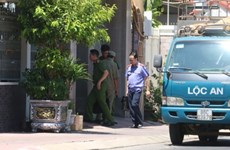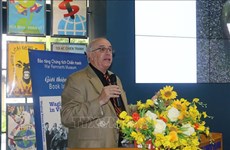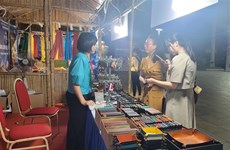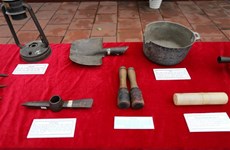Battle to heal wounds of AO continues, say U.S. experts
More than 30 years after the bullets stopped flying in Vietnam, a
battle rages to help people still suffering from the effects of Agent
Orange , U.S. experts said at a discussion held in North Carolina
state on Feb 16.
More than 30 years after the bullets stopped flying in Vietnam, a
battle rages to help people still suffering from the effects of Agent
Orange , U.S. experts said at a discussion held in North Carolina
state on Feb 16.
During a panel discussion at the University of North Carolina , Charles Bailey, Director of Ford Foundation's Special Initiative on Agent Orange/Dioxin, said that Agent Orange was an herbicide, later discovered to be contaminated with the toxic nerve gas dioxin, that the U.S. military sprayed on the jungles of Vietnam to hamper guerrilla operations. He added: "If you use herbicides to kill the trees and shrubs, it exposes the tropical soil to tropical rains and degradation, and it’s very hard to get anything to grow again".
Other experts said during the discussion that lingering health and environmental problems from Agent Orange affected an estimated 3 million Vietnamese, including 150,000 children.
Research has shown an increased number of Vietnamese children have been born with severe birth defects and Down syndrome since the war ended in 1975, panelists said.
"Wars aren’t over when the last soldiers leave the battlefield," said Bob Edgar, President of the non-profit Common Cause, which is working on the Agent Orange issue in Vietnam .
As a congressman at the end of the Vietnam War, Edgar pushed legislation to help veterans impacted by Agent Orange. Now, his focus is on the people of Vietnam .
North Carolina - based e-paper WRAL.com in an article posted on Feb. 16 onto "http://www.wral.com" quoted Edgar as saying at the discussion that he had seen "people there affected by unbelievable birth defects, spina bifida, cleft pallets and hair lips and other facial disfigurements".
According to Bailey, a number of U.S. groups, including the Ford Foundation and Common Cause, aim to raise 30 million USD each year over the next decade to clean contaminated Agent Orange hot spots and provide health services for families and children affected by Agent Orange, which, during the war, the U.S. military sprayed 20 million gallons (1 gallon=3.785 litres) to destroy some 5 million acres (1 acre=4,046 sq.m) in Vietnam.
Bailey said: "Rather than continue the 40-year acrimony over the science, we're simply saying: This is a humanitarian issue, and we can do something about it"./.
During a panel discussion at the University of North Carolina , Charles Bailey, Director of Ford Foundation's Special Initiative on Agent Orange/Dioxin, said that Agent Orange was an herbicide, later discovered to be contaminated with the toxic nerve gas dioxin, that the U.S. military sprayed on the jungles of Vietnam to hamper guerrilla operations. He added: "If you use herbicides to kill the trees and shrubs, it exposes the tropical soil to tropical rains and degradation, and it’s very hard to get anything to grow again".
Other experts said during the discussion that lingering health and environmental problems from Agent Orange affected an estimated 3 million Vietnamese, including 150,000 children.
Research has shown an increased number of Vietnamese children have been born with severe birth defects and Down syndrome since the war ended in 1975, panelists said.
"Wars aren’t over when the last soldiers leave the battlefield," said Bob Edgar, President of the non-profit Common Cause, which is working on the Agent Orange issue in Vietnam .
As a congressman at the end of the Vietnam War, Edgar pushed legislation to help veterans impacted by Agent Orange. Now, his focus is on the people of Vietnam .
North Carolina - based e-paper WRAL.com in an article posted on Feb. 16 onto "http://www.wral.com" quoted Edgar as saying at the discussion that he had seen "people there affected by unbelievable birth defects, spina bifida, cleft pallets and hair lips and other facial disfigurements".
According to Bailey, a number of U.S. groups, including the Ford Foundation and Common Cause, aim to raise 30 million USD each year over the next decade to clean contaminated Agent Orange hot spots and provide health services for families and children affected by Agent Orange, which, during the war, the U.S. military sprayed 20 million gallons (1 gallon=3.785 litres) to destroy some 5 million acres (1 acre=4,046 sq.m) in Vietnam.
Bailey said: "Rather than continue the 40-year acrimony over the science, we're simply saying: This is a humanitarian issue, and we can do something about it"./.













